![The ruins of the Theatre of Zea [el], next to the Archaeological Museum of Piraeus 7651 - Piraeus Arch. Museum, Athens - Greek theatre - Photo by Giovanni Dall'Orto, Nov 14 2009.jpg](http://upload.wikimedia.org/wikipedia/commons/thumb/b/b4/7651_-_Piraeus_Arch._Museum%2C_Athens_-_Greek_theatre_-_Photo_by_Giovanni_Dall%27Orto%2C_Nov_14_2009.jpg/220px-7651_-_Piraeus_Arch._Museum%2C_Athens_-_Greek_theatre_-_Photo_by_Giovanni_Dall%27Orto%2C_Nov_14_2009.jpg)
The Archaeological Museum of Piraeus contains mainly sculptures, discovered in Piraeus and in the area of the Attic coast from Bronze Age to Roman times, [1]
![The ruins of the Theatre of Zea [el], next to the Archaeological Museum of Piraeus 7651 - Piraeus Arch. Museum, Athens - Greek theatre - Photo by Giovanni Dall'Orto, Nov 14 2009.jpg](http://upload.wikimedia.org/wikipedia/commons/thumb/b/b4/7651_-_Piraeus_Arch._Museum%2C_Athens_-_Greek_theatre_-_Photo_by_Giovanni_Dall%27Orto%2C_Nov_14_2009.jpg/220px-7651_-_Piraeus_Arch._Museum%2C_Athens_-_Greek_theatre_-_Photo_by_Giovanni_Dall%27Orto%2C_Nov_14_2009.jpg)
The Archaeological Museum of Piraeus contains mainly sculptures, discovered in Piraeus and in the area of the Attic coast from Bronze Age to Roman times, [1]

The museum's displayed objects are divided in sections: [2]
The old building of the museum (330 m2 [1] ), which is currently used as a storage room, was built in 1935. [3] The new two-store building, which was inaugurated in 1981, [3] covers a total area of total 1.394 m2. Both buildings neighbour on the Zeas (Greek : Ζέα) ancient classical theater. In the near future, the theater site is going to be used as an open-air sculpture exhibition. [1]
The museum is accessible with the Athens metro or bus lines. It is 15-minute walk from Piraeus station and a couple minute walk from bus station. Moreover, it is a 5-minute walk from the area for the reception of Cruise ships of the Piraeus port.

Kerameikos also known by its Latinized form Ceramicus, is an area of Athens, Greece, located to the northwest of the Acropolis, which includes an extensive area both within and outside the ancient city walls, on both sides of the Dipylon Gate and by the banks of the Eridanos River. It was the potters' quarter of the city, from which the English word "ceramic" is derived, and was also the site of an important cemetery and numerous funerary sculptures erected along the Sacred Way, a road from Athens to Eleusis.

Piraeus is a port city within the Athens urban area, in the Attica region of Greece. It is located eight kilometres (5 mi) southwest of Athens city centre along the east coast of the Saronic Gulf in the Athens Riviera.

The ancient Agora of Athens is the best-known example of an ancient Greek agora, located to the northwest of the Acropolis and bounded on the south by the hill of the Areopagus and on the west by the hill known as the Agoraios Kolonos, also called Market Hill. The Agora's initial use was for a commercial, assembly, or residential gathering place.

The Stoa of Attalos was a stoa in the Agora of Athens, Greece. It was built by and named after King Attalos II of Pergamon, who ruled between 159 and 138 BC. The building was reconstructed from 1952 to 1956 by the American School of Classical Studies at Athens and currently houses the Museum of the Ancient Agora.
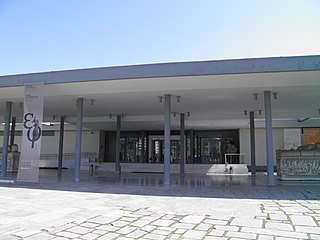
The Archaeological Museum of Thessaloniki is a museum in Thessaloniki, Central Macedonia, Greece. It holds and interprets artifacts from the Prehistoric, Archaic, Classical, Hellenistic and Roman periods, mostly from the city of Thessaloniki but also from the region of Macedonia in general.

The sculpture of ancient Greece is the main surviving type of fine ancient Greek art as, with the exception of painted ancient Greek pottery, almost no ancient Greek painting survives. Modern scholarship identifies three major stages in monumental sculpture in bronze and stone: the Archaic, Classical and Hellenistic. At all periods there were great numbers of Greek terracotta figurines and small sculptures in metal and other materials.
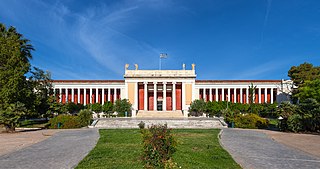
The National Archaeological Museum in Athens houses some of the most important artifacts from a variety of archaeological locations around Greece from prehistory to late antiquity. It is considered one of the greatest museums in the world and contains the richest collection of Greek Antiquity artifacts worldwide. It is situated in the Exarcheia area in central Athens between Epirus Street, Bouboulinas Street and Tositsas Street while its entrance is on the Patission Street adjacent to the historical building of the Athens Polytechnic university.

Classical sculpture refers generally to sculpture from Ancient Greece and Ancient Rome, as well as the Hellenized and Romanized civilizations under their rule or influence, from about 500 BC to around 200 AD. It may also refer more precisely a period within Ancient Greek sculpture from around 500 BC to the onset of the Hellenistic style around 323 BC, in this case usually given a capital "C". The term "classical" is also widely used for a stylistic tendency in later sculpture, not restricted to works in a Neoclassical or classical style.

The study of Roman sculpture is complicated by its relation to Greek sculpture. Many examples of even the most famous Greek sculptures, such as the Apollo Belvedere and Barberini Faun, are known only from Roman Imperial or Hellenistic "copies". At one time, this imitation was taken by art historians as indicating a narrowness of the Roman artistic imagination, but, in the late 20th century, Roman art began to be reevaluated on its own terms: some impressions of the nature of Greek sculpture may in fact be based on Roman artistry.

The Heraklion Archaeological Museum is a museum located in Heraklion on Crete. It is one of the largest museums in Greece and the best in the world for Minoan art, as it contains by far the most important and complete collection of artefacts of the Minoan civilization of Crete. It is normally referred to scholarship in English as "AMH", a form still sometimes used by the museum in itself.

The Antikythera Ephebe, registered as Bronze statue of a youth in the museum collections, is a Greek bronze statue of a young man of languorous grace that was found in 1900 by sponge-divers in the area of the ancient Antikythera shipwreck off the island of Antikythera, Greece. It was the first of the series of Greek bronze sculptures that the Aegean and Mediterranean yielded up in the twentieth century which have fundamentally altered the modern view of ancient Greek sculpture. The wreck site, which is dated about 70–60 BC, also yielded the Antikythera mechanism, a characterful head of a Stoic philosopher, and a hoard of coins. The coins included a disproportionate quantity of Pergamene cistophoric tetradrachms and Ephesian coins, leading scholars to surmise that it had begun its journey on the Ionian coast, perhaps at Ephesus; none of its recovered cargo has been identified as from mainland Greece.
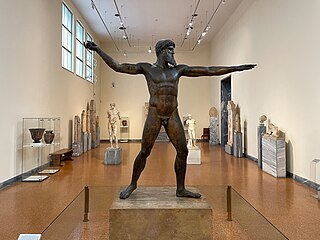
The Artemision Bronze is an ancient Greek sculpture that was recovered from the sea off Cape Artemision, in northern Euboea, Greece. According to most scholars, the bronze represents Zeus, the thunder-god and king of gods, though it has also been suggested it might represent Poseidon. The statue is slightly over lifesize at 2.09 meters, and would have held either a thunderbolt, if Zeus, or a trident if Poseidon. The empty eye-sockets were originally inset, probably with bone, as well as the eyebrows, the lips, and the nipples. The sculptor is unknown. The statue is a highlight of the collections in the National Archaeological Museum of Athens.

Etruscan art was produced by the Etruscan civilization in central Italy between the 10th and 1st centuries BC. From around 750 BC it was heavily influenced by Greek art, which was imported by the Etruscans, but always retained distinct characteristics. Particularly strong in this tradition were figurative sculpture in terracotta, wall-painting and metalworking especially in bronze. Jewellery and engraved gems of high quality were produced.

Delphi Archaeological museum is one of the principal museums of Greece and one of the most visited. It is operated by the Greek Ministry of Culture. Founded in 1903, it has been rearranged several times and houses the discoveries made at the Panhellenic sanctuary of Delphi, which date from the Late Helladic (Mycenean) period to the early Byzantine era.

The Archaeological Museum of Olympia is one of the principal museums of Greece, located in Olympia. It is overseen by the Ministry of Culture and Sports, and, as of 2009, is directed by Georgia Xatzi. When the original building was completed and opened in 1888, it was the first museum in Greece outside of Athens.

The Archaeological Museum of Delos is a museum on the island of Delos, near Mykonos in the South Aegean, Greece. It is noted for its extensive collection of statues unearthed in the surrounding area of the ancient site, which has been declared a UNESCO World Heritage Site. Although the museum has a considerable collection, it does not contain all of the items found in Delos: a large quantity are on display in Athens at the National Archaeological Museum.
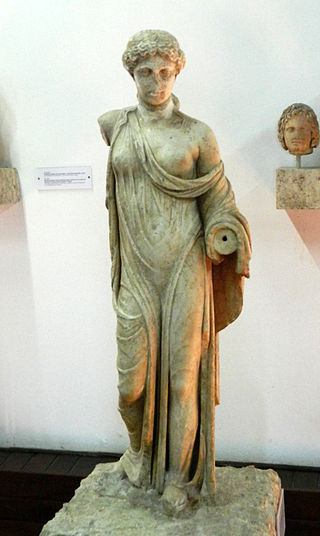
The Archaeological Museum of Lamia is a museum within the archaeological site of Lamia Castle in Lamia, Greece. The museum is housed in a refurbished barracks built in 1830 by King Otto of Greece. It presents prehistoric and Classical antiquities, covering the Neolithic era, Helladic period, Early Iron Age, Archaic, Classical and Hellenistic periods.
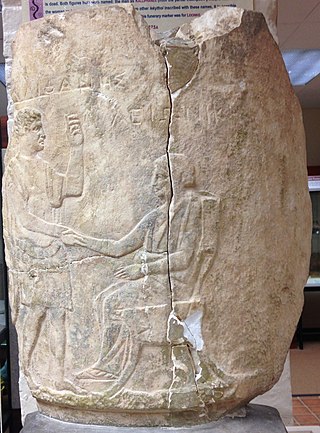
The Museum of Classical Archaeology is the teaching collection of the Department of Classics, Archaeology and Ancient History at the University of Adelaide in South Australia.

Ancient Greek art stands out among that of other ancient cultures for its development of naturalistic but idealized depictions of the human body, in which largely nude male figures were generally the focus of innovation. The rate of stylistic development between about 750 and 300 BC was remarkable by ancient standards, and in surviving works is best seen in sculpture. There were important innovations in painting, which have to be essentially reconstructed due to the lack of original survivals of quality, other than the distinct field of painted pottery.

The Archaeological Museum of Milos is a museum in Plaka on the island of Milos, in Greece. Its collections include exhibits dating from the late Neolithic to the Byzantine period. The unique is collection of ancient Cycladic art, especially numerous findings from Phylakopi on Milos, from early Bronze Age to the late Bronze Age. The best pieces from Phylakopi are in the Ashmolean Museum (Oxford), British Museum, National Museum of Athens, and elsewhere around the world.
![]() Media related to Archaeological Museum of Piraeus (Athens) at Wikimedia Commons
Media related to Archaeological Museum of Piraeus (Athens) at Wikimedia Commons